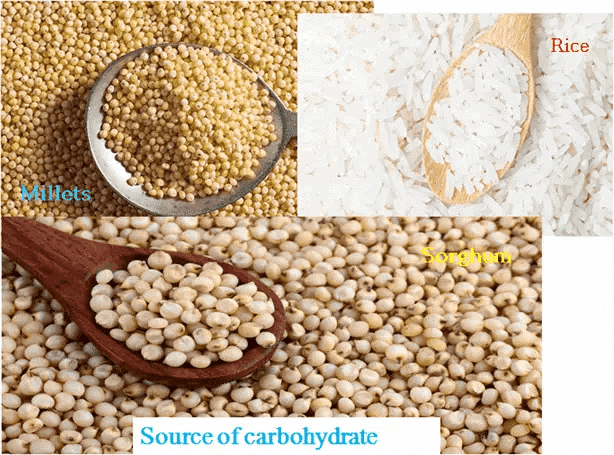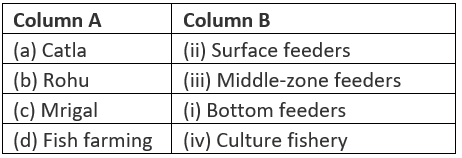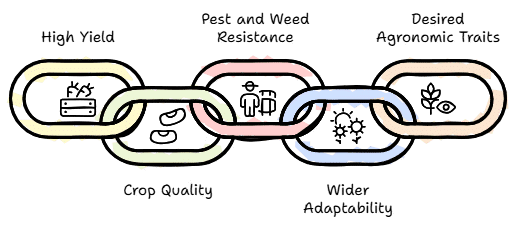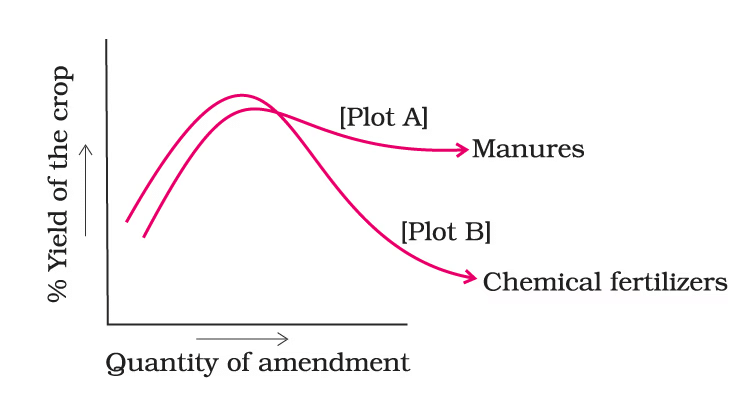NCERT Exemplar: Improvement in Food Resources | Science Class 9 PDF Download
Multiple Choice Questions
Q.1. Which one is an oil yielding plant among the following?
(a) Lentil
(b) Sunflower
(c) Cauliflower
(d) Hibiscus
Ans: (b)
Explanation:Lentils are pulse yielding plants. Cauliflower is a vegetable and Hibiscus is a flower, whereas Sunflower is used to make oil.
Q.2. Which one is not a source of carbohydrates?
(a) Rice
(b) Millets
(c) Sorghum
(d) Gram
Ans: (d)
Explanation:Rice, millets and sorghum has carbohydrates in them as a major source of energy. Whereas gram is a dicotyledon which is rich in proteins hence gram is the answer.
Q.3. Find out the wrong statement from the following
(a) White revolution is meant for increase in milk production
(b) Blue revolution is meant for increase in fish production
(c) Increasing food production without compromising with environmental quality is called as sustainable agriculture
(d) None of the above
Ans: (d)
Explanation: Statements provided in option a), b) and c) are right statements hence answer is d) none of the above.
(a) White Revolution → Related to an increase in milk production, initiated by Dr. Verghese Kurien in India.
(b) Blue Revolution → Associated with increased fish production through aquaculture.
(c) Sustainable Agriculture → A method of farming that enhances food production while preserving environmental quality.
Q.4. To solve the food problem of the country, which among the following is necessary?
(a) Increased production and storage of food grains
(b) Easy access of people to the food grain
(c) People should have money to purchase the grains
(d) All of the above
Ans: (d)
Explanation: Food security requires increased production, proper storage, availability, and affordability. Without storage, grains may spoil; without access or purchasing power, people may still suffer from hunger.
Q.5. Find out the correct sentence
(i) Hybridisation means crossing between genetically dissimilar plants
(ii) Cross between two varieties is called as inter specific hybridisation
(iii) Introducing genes of desired character into a plant gives genetically modified crop
(iv) Cross between plants of two species is called as inter varietal hybridisation
(a) (i) and (iii)
(b) (ii) and (iv)
(c) (ii) and (iii)
(d) (iii) and (iv)
Ans: (a)
Explanation: Hybridization refers to crossing genetically dissimilar plants to obtain better traits (i). Genetically modified crops are created by introducing desired genes into plants for improved characteristics (iii). However, inter-specific hybridization (ii) refers to a cross between different species, not just varieties, and inter-varietal hybridization (iv) refers to a cross between different varieties, not species. Hence, only (i) and (iii) are correct.
Q.6. Weeds affect the crop plants by
(a) killing of plants in field before they grow
(b) dominating the plants to grow
(c) competing for various resources of crops (plants) causing low availability of nutrients
(d) all of the above
Ans: (c)
Explanation: Few weeds are poisonous but it does not affect the crop plant. Weeds compete for the nutrients and water available in the soil. This makes the crop plant devoid of nutrients than the requirement which leads to a decrease of the crop yield.
Q.7. Which one of the following species of honey bee is an Italian species?
(a) Apis dorsata
(b) Apis florae
(c) Apis cerana indica
(d) Apis mellifera
Ans:(d)
Explanation: Apis mellifera is an Italian species of honey bee, known for its high honey production, adaptability, and gentle nature, making it ideal for commercial beekeeping. In contrast, Apis dorsata (rock bee) is a large, wild species found in India, Apis florae (little bee) produces less honey, and Apis cerana indica (Indian bee) is commonly domesticated but yields lower honey compared to Apis mellifera.
Q.8. Find out the correct sentence about manure
(i) Manure contains large quantities of organic matter and small quantities of nutrients.
(ii) It increases the water holding capacity of sandy soil.
(iii) It helps in draining out of excess of water from clayey soil.
(iv) Its excessive use pollutes environment because it is made of animal excretory waste.
(a) (i) and (iii)
(b) (i) and (ii)
(c) (ii) and (iii)
(d) (iii) and (iv)
Ans:(a)
Explanation:Manure improves water holding capacity hence it cannot be responsible for draining out of excess water. Manure usage is not responsible for pollution. Using manure is an eco-friendly method of using fertilizers.
Q.9. Cattle husbandry is done for the following purposes
(i) Milk Production
(ii) Agricultural work
(iii) Meat production
(iv) Egg production
(a) (i), (ii) and (iii)
(b) (ii), (iii) and (iv)
(c) (iii) and (iv)
(d) (i) and (iv)
Ans:(a)
Explanation:Cattle husbandry is done for the purpose of milk production, agricultural work and meat production. But poultry farming is done for egg production.
Q.10. Which of the following are Indian cattle?
(i) Bos indicus
(ii) Bos domestica
(iii) Bos bubalis
(iv) Bos vulgaris
(a) (i) and (iii)
(b) (i) and (ii)
(c) (ii) and (iii)
(d) (iii) and (iv)
Ans:(a)
Explanation: Bos domestica is found in Africa and Bos Vulgaris does not belong to Bos family.
Q.11. Which of the following are exotic breeds?
(i) Brawn
(ii) Jersey
(iii) Brown Swiss
(iv) Jersey Swiss
(a) (i) and (iii)
(b) (ii) and (iii)
(c) (i) and (iv)
(d) (ii) and (iv
Ans: (b)
Explanation: Jersey (UK) and Brown Swiss (Switzerland) are exotic cattle breeds known for high milk yield. Brawn is not a breed, and Jersey Swiss is incorrect (should be Brown Swiss). Hence, the correct answer is (b) Jersey and Brown Swiss.
Q.12. Poultry farming is undertaken to raise the following
(i) Egg production
(ii) Feather production
(iii) Chicken meat
(iv) Milk production
(a) (i) and (iii)
(b) (i) and (ii)
(c) (ii) and (iii)
(d) (iii) and (iv)
Ans: (a)
Explanation:Hen does not produce milk and they are not reared for the purpose of feathers hence option ii) and iv) are wrong statements.
Q.13. Poultry fowl are susceptible to the following pathogens
(a) Viruses
(b) Bacteria
(c) Fungi
(d) All of the above
Ans: (d)
Explanation:Viruses, bacteria and fungi causes diseases in poultry.
Q.14. Which one of the following fishes is a surface feeder?
(a) Rohus
(b) Mrigals
(c) Common carps
(d) Catlas
Ans: (d)
Explanation: Catla is a surface feeder, primarily feeding on plankton near the water surface. In contrast, Rohu feeds in the middle layers, Mrigal is a bottom feeder, and Common Carp is an omnivorous feeder at different water levels.
Q.15. Animal husbandry is the scientific management of
(i) animal breeding
(ii) culture of animals
(iii) animal livestock
(iv) rearing of animals
(a) (i), (ii) and (iii)
(b) (ii), (iii) and (iv)
(c) (i), (ii) and (iv)
(d) (i), (iii) and (iv)
Ans: (d)
Explanation: Animal husbandry involves scientific breeding, livestock management, and rearing of animals for better productivity. While culture of animals (ii) is a vague term, breeding (i), livestock management (iii), and rearing (iv) are key components. Hence, the correct answer is (d).
Q.16. Which one of the following nutrients is not available in fertilizers?
(a) Nitrogen
(b) Phosphorus
(c) Iron
(d) Potassium
Ans: (c)
Explanation: Plants obtain iron from nutrients in the soil. There is no fertilizer that can provide iron for the plants.
Q.17. Preventive and control measures adopted for the storage of grains include
(a) strict cleaning
(b) proper disjoining
(c) fumigation
(d) all of the above
Ans:(d)
Explanation: Grain storage requires strict cleaning to remove pests, proper disjoining to prevent infestation, and fumigation to eliminate insects. These measures help in preserving grain quality and preventing spoilage.
Short Answer Questions
Q.18. Match the column A with the column B Ans:
Ans:
Q.19. Fill in the blanks
(a) Pigeon pea is a good source of ———.
(b) Berseem is an important———crop.
(c) The crops which are grown in rainy season are called———crops.
(d) ———are rich in vitamins.
(e) ——— crop grows in winter season.
Ans: (a) Pigeon pea is a good source of Protein.
(b) Berseem is an important fodder crop.
(c) The crops which are grown in rainy season are called Kharif crops.
(d) Vegetablesare rich in vitamins.
(e) Rabicrop grows in winter season.
Q.20. What is a GM crop? Name any one such crop which is grown in India.
Ans: A GM crop is the one which is developed by introducing the desired gene from a different source into the target crop. Crops are genetically modified to obtain the desired character. Example: BT cotton which has an insect-resistant gene from bacteria is grown in India.
Q.21. List out some useful traits in improved crop?
Ans: Below are the useful traits in the improved crop.
- High yield of the crop
- Improved crop quality
- Pest and weed resistance
- Wider adaptability
- Expression of desired agronomic characters.
Q.22. Why is organic matter important for crop production?
Ans: Organic matter is very important for crop production because of the following reasons
- Organic matter provides necessary minerals for the crops
- Organic matter loosens the soil structure to provide necessary aeration for the roots.
- Organic matter improves the water holding capacity of the soil.
- Organic matter helps in drainage and to avoid waterlogging in clayey soil.
Q.23. Why is excess use of fertilizers detrimental for the environment?
Ans: Excess use of fertilizers is detrimental for the environment because the residue of fertilizers causes pollution in the air, water and soil which proves costly.
Q.24. Give one word for the following
(a) Farming without the use of chemicals as fertilizers, herbicides and pesticides is known as ———.
(b) Growing of wheat and groundnut on the same field is called as ———.
(c) Planting soyabean and maize in alternate rows in the same field is called as ———.
(d) Growing different crops on a piece of land in pre-planned succession is known as———.
(e) Xanthium and Parthenium are commonly known as———.
(f) Causal organism of any disease is called as ———.
Ans: (a) Farming without the use of chemicals as fertilizers, herbicides and pesticides is known as organic farming.
(b) Growing of wheat and groundnut on the same field is called as mixed cropping.
(c) Planting soybean and maize in alternate rows in the same field is called intercropping.
(d) Growing different crops on a piece of land in pre-planned succession is known as crop rotation.
(e) Xanthium and Parthenium are commonly known as weeds.
(f) The causal organism of any disease is called pathogen.
Q.25. Match the following A and B
Ans: Q.26. If there is low rainfall in a village throughout the year, what measures will you suggest to the farmers for better cropping?
Q.26. If there is low rainfall in a village throughout the year, what measures will you suggest to the farmers for better cropping?
Ans: Farmers are suggested to grow drought-resistant crops which can mature early. Along with this farmers are advised to use manure for their field as it increases the water-holding capacity of the soil.
Q.27. Group the following and tabulate them as energy-yielding, protein yielding, oil yielding and fodder crop. Wheat, rice, berseem, maize, gram, oat, pigeon gram, sudangrass, lentil, soybean, groundnut, castor and mustard.
Ans: Energy Yielding crop- Wheat rice Maize
Protein Yielding crop- gram, pigeon gram, lentil, soybean
Oil yielding crop- groundnut, castor, mustard, soybean
Fodder crop- berseem, oat, sudangrass
Q.28. Define the term hybridization and photoperiod.
Ans: Hybridization– Crossing between genetically different organisms to produce desired characteristics in the offspring is known as hybridization.
Duration of the sunlight available for a plant is called as photoperiod. Photoperiod is responsible for the growth of the plant.
Q.29. Fill in the blanks
(a) Photoperiod affect the ————.
(b) Kharif crops are cultivated from ———— to ————.
(c) Rabi crops are cultivated from ———— to ————.
(d) Paddy, maize, green gram and black gram are ———— crops.
(e) Wheat, gram, pea, mustard are ———— crops.
Ans: (a) Photoperiod affects the Flowering process
(b) Kharif crops are cultivated from June to October.
(c) Rabi crops are cultivated from Novemeber to April.
(d) Paddy, maize, green gram and black gram are Kharifcrops.
(e) Wheat, gram, pea, mustard are Rabi crops.
Q.30. Cultivation practices and crop yield are related to environmental condition. Explain.
Ans: Different crops need different climatic conditions for the growth such as temperature, photoperiod and water. Some of the crops grown in the rainy season which are called Kharif and some grow in winter which is called Rabi crops.
Q.31. Fill in the blanks
(a) A total of——nutrients are essential to plants.
(b) ———and———are supplied by air to plants.
(c) ———is supplied by water to plants.
(d) Soil supply———nutrients to plants.
(e) ———nutrients are required in large quantity and called———.
(f) ——— nutrients are needed in small quantity for plants and are called ———.
Ans: (a) A total of 16 nutrients are essential to plants.
(b) Carbon dioxide andoxygenare supplied by air to plants.
(c) Hydrogen is supplied by water to plants.
(d) Soil supply 13 nutrients to plants.
(e) 6 nutrients are required in large quantity and called macronutrients.
(f) 7 nutrients are needed in small quantity for plants and are called micronutrients.
Q.32. Differentiate between compost and vermicompost?
Ans: Compost is formed by using farm waste materials like livestock excreta, vegetable waste, domestic waste, straw, discarded weeds. These all are decomposed and are used as manure for the farms.
Vermicompost is s compost prepared by using organic matter. Here composting is done by using earthworms.
Q.33. Arrange these statements in correct sequence of preparation of green manure.
(a) Green plants are decomposed in soil.
(b) Green plants are cultivated for preparing manure or crop plant parts are used.
(c) Plants are ploughed and mixed into the soil.
(d) After decomposition it becomes green manure.
Ans: (b) Green plants are cultivated for preparing manure or crop plant parts are used.
(c) Plants are ploughed and mixed into the soil.
(a) Green plants are decomposed in soil.
(d) After decomposition, it becomes green manure.
Q.34. An Italian bee variety A. mellifera has been introduced in India for honey production. Write about its merits over other varieties.
Ans: Advantages of Italian bee variety A. mellifera over other bee varieties are as follows
- They stings less
- Their honey collection capacity is maximum.
- In stays in a single beehive for a very long period of time
- Its breeding capacity is high.
Q.35. In agricultural practices, higher input gives higher yield. Discuss how
Ans: Higher inputs give higher yield refers to the facilities and financial status of a farmer. The good financial status allows farmers to take up new methodologies and technologies to increase the yield. Higher buying capacity decides to crop methods and agricultural practices.
Long Answer Questions
Q.36. Discuss the role of hybridisation in crop improvement.
Ans: Hybridization is a method of crossing two dissimilar varieties to get desirable characters in the off-springs. Hybridization improves the crop in the following attributes
High yield: Hybridization helps to improve crop yield
Pest resistance: Crop can obtain pest resistance by incorporating pest resistance genes. Ex: BT Cotton
Draught resistance: Plants obtain drought-resistant genes from drought-resistant varieties.
Disease resistance: Plants can be immune to certain disease against which genes are incorporated.
Q.37. Define (i) Vermicompost (ii) Green manure (iii) Biofertilizer
Ans: Vermicompost: Manure is rich in organic materials. Vermicompost is prepared by using earthworms, plant and animal waste. Earthworms helps in composting organic waste to give nutrient-rich manure.
Green Manure: Manure prepared by composting green plant is known as green. Green manure is usually made in the field Ex: Hemp is allowed to decompose to get green manure.
Bio-fertilizers: Usage of living organisms to provide nutrient to plant and to make the soil fertile is known as biofertilizers. Ex: Blue-green algae used as bio-fertilizer in paddy fields.
Q.38. Discuss various methods for weed control.
Ans: Various methods of weed control are listed below
- Mechanical removal
- Preparation of seedbed
- Timely sowing of the desired crop
- Crop rotation
Q.39. Differentiate between the following
(i) Capture fishery and Culture fishery
(ii) Mixed cropping and Inter cropping
(iii) Bee keeping and Poultry farming
Ans: Capture fishery is traditional fishing where a fisherman catches the fishes from natural resources like sea and rives. Culture fishery is the one where the fishes are obtained reared for the commercial purpose.
Mixed cropping is the method of growing two or more crops in a single field. Intercropping is a type of mixed cropping where two or more crops are grown in a single field in a definite pattern.
Bee keeping is the method of rearing bees to obtain honey. Poultry farming is a method of raising domestic fowl for the purpose of egg and meat.
Q.40. Give the merits and demerits of fish culture?
Ans: Merits of Fish culture
Desired fishes can be obtained in a large amount in a small area.
Improved food quality as fishes is the cheap source of proteins.
Demerits of fish culture
Only desired varieties of fishes are reared
It is a threat to biodiversity.
Q.41. What do you understand by composite fish culture?
Ans: Composite fish culture is a method of rearing five to six varieties of fish species in a single pond. Species are selected in such a way that they should not compete with others for food because of change in their food habits. Hence fishes use food available in the pond. Ex: Catla’s are surface feeders. Rohu is middle zone feeder and common caps are bottom feeders.
Q.42. Why bee keeping should be done in good pasturage?
Ans: Bees need quality nectar to produce honey. A good pasturage consists of plenty of flowers which can be used by bees to get quality nectar. This increase the quality as well as the quantity of the bees. If bees are confined to only single variety of flowers for nectar honey quality will have similar taste, consistency. Most of the farmers make honey obtained from single nectar.
Q.43. Write the modes by which insects affect the crop yield.
Ans: Below are the modes by which insects decrease crop yield.
(a) Cutting:Insects cut plant parts such as leaves, fruits, flowers etc. This damages the plant, damaged leaves result in a decreased rate of photosynthesis, decreased flower decreases the production of seeds.
(b) Borers:Some pests boreholes in specific plant parts and start living inside. These pests utilize plant nutrients and food which result in the decrease in the yield.
(c) Suckers:Few pests suck cell sap by using their proboscis. This result in an adverse effect on the plant which reduces the yield.
Q.44. Discuss why pesticides are used in very accurate concentration and in very appropriate manner?
Ans: Pesticides are used in very accurate and in a very appropriate manner because of the following reasons
Excess use of pesticides will reduce the fertility of the soil.
- Reduces the organic matter present in the soil
- Kills useful microorganisms present in the soil.
- Causes air, water and soil pollution.
Q.45. Name two types of animal feed and write their functions.
Ans: Roughage
Roughages are provided by husk, grass and chopped leaves. Roughages give complete nourishment to animals and roughages aid proper digestion in animals.
Concentrates
These are prepared as per the requirement of particular cattle and they are highly ricked in proteins and minerals. Varieties of concentrates are available in the market.
Q.46. What would happen if poultry birds are larger in size and have no summer adaptation capacity? In order to get small sized poultry birds, having summer adaptability, what method will be employed?
Ans: Temperature maintenance is vital for better egg production. Even though if the size of poultry birds is large but without temperature adaptation egg production may decrease. To obtain high adaptability and small-sized poultry. Crossbreeding of poultry birds is done. The small size also require small food and a small area to rear.
Q.47. Suggest some preventive measures for the diseases of poultry birds.
Ans: Preventive measures to avoid disease in poultry are
1. Cleaning:It is very important to maintain hygiene. Poultry farms should be cleaned regularly to maintain hygiene in the farm.
2. Sanitation: Sanitation should be maintained inside the farm
3. Disinfectatnts: Disinfectant should be sprayed on a regular basis.
4. Vaccination:Birds should be vaccinated to prevent disease in poultry.
Q.48. Figure15.1 shows the two crop fields [Plots A and B] have been treated by manures and chemical fertilizers respectively, keeping other environmental factors same. Observe the graph and answer the following questions.
(i) Why does plot B show sudden increase and then gradual decrease in yield?
(ii) Why is the highest peak in plot A graph slightly delayed?
(iii) What is the reason for the different pattern of the two graphs?
Ans: (i) When we chemical fertilizers there will be a sudden increase in the yield as nutrients are released abundantly. But with time crop yield decrease because excess usage of chemical fertilizers kills the useful micro-organisms present in the soil and also reduces the organic material present in the soil.
(ii) Manure release the nutrients slowly as they are rich in organic matter. But manure enriches the soil by providing nutrients and necessary environment for the growth of useful micro-organisms.
(iii) Different pattern in the graph is due to the release of nutrients into the soil by two different methods. The graph shows that excessive usage of chemical fertilizers is detrimental and using manure is beneficial for a long time. Yield remains high when the quantity of the manure increases.
Q.49. Complete the crossword puzzle (Fig.15.2)
Across
1. Oil yielding plant (9)
3. Crop grown in winter season (4)
5. Fixed by Rhizobium (8)
9. Common honey bee (4)
Downward
2. Animal feed (6)
4. A micronutrient (5)
6. Unwanted plant in crop fields (4)
7. An exotic breed of chicken(7)
8. Bottom feeders in fish pond(7)
10. A marine fish (4)
Ans: Across:
1. Sunflower
3. Rabi
5. Nitrogen
9. Apis
Down
2. Fodder
4. Boron
6. Weed
7. Leghorn
8. Mrigals
10. Tuna
|
84 videos|384 docs|61 tests
|
FAQs on NCERT Exemplar: Improvement in Food Resources - Science Class 9
| 1. What are the key methods to improve food resources as discussed in the NCERT Exemplar? |  |
| 2. How does the concept of sustainable agriculture relate to food resource improvement? |  |
| 3. What role do government policies play in improving food resources? |  |
| 4. Can biotechnology contribute to improving food resources? If so, how? |  |
| 5. What are the challenges faced in improving food resources? |  |


















